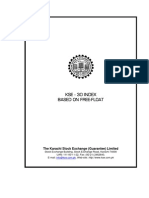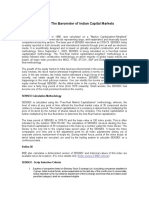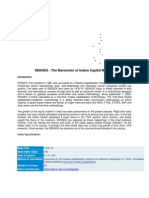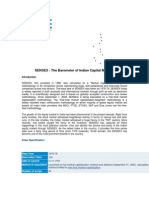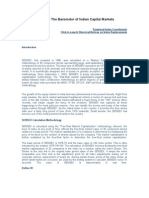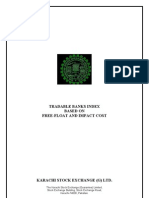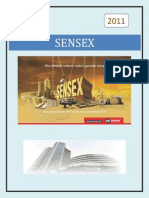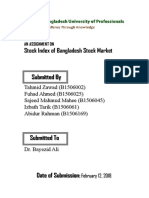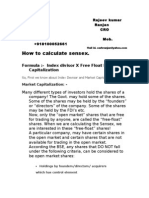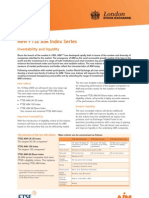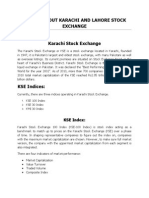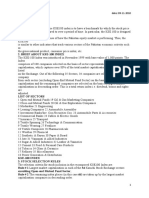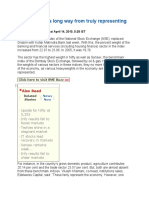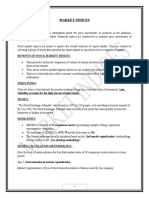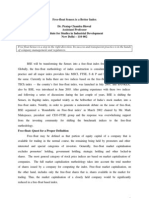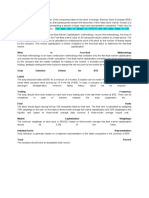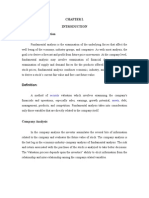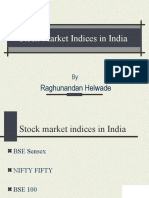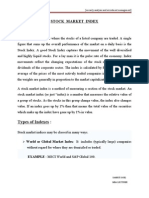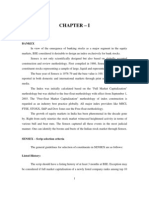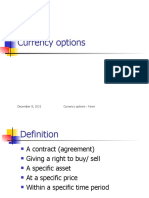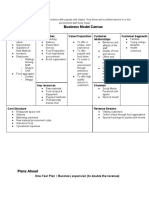Kse - 30 Index Based On Free-Float: Pakistan Stock Exchange Limited
Kse - 30 Index Based On Free-Float: Pakistan Stock Exchange Limited
Uploaded by
Abdullah AbdullahCopyright:
Available Formats
Kse - 30 Index Based On Free-Float: Pakistan Stock Exchange Limited
Kse - 30 Index Based On Free-Float: Pakistan Stock Exchange Limited
Uploaded by
Abdullah AbdullahOriginal Description:
Original Title
Copyright
Available Formats
Share this document
Did you find this document useful?
Is this content inappropriate?
Copyright:
Available Formats
Kse - 30 Index Based On Free-Float: Pakistan Stock Exchange Limited
Kse - 30 Index Based On Free-Float: Pakistan Stock Exchange Limited
Uploaded by
Abdullah AbdullahCopyright:
Available Formats
KSE - 30 INDEX
BASED ON FREE-FLOAT
Pakistan Stock Exchange Limited
Stock Exchange Building, Stock Exchange Road, Karachi-74000
UAN: 111-00-11-22, Fax: (92-21) 32462640,
E-mail: info@psx.com.pk, Web-site: http://www.psx.com.pk
TABLE OF CONTENTS
Sr. Contents Page
No. No.
1. Brief of PSX Indices 1
2. Introduction of KSE-30 Index 2
3. Free-Float Methodology 3
4. Pre-Requisites to Qualify for Inclusion in KSE-30 Index 5
5. Selection Criteria 6
6. Base Period 7
7. Maintenance of KSE-30 Index 8
8. Review Period 8
9. On-line Computation of the Index 8
10. Adjustment for Cash Dividend, Bonus, Right and Newly Issued 8
Capital
11. Composition of Companies included in KSE-30 Index based on 18
June 30, 2005
12. List of Companies included in the KSE-30 Index on the basis of 19
Re-composition as on June 30, 2018
KSE-30 Index
1. BRIEF OF PSX INDICES
The Pakistan Stock Exchange is maintaining two indices, which are in place
i.e. KSE 100 Index and KSE All Share Index. Both the said indices are market
capitalization-based indices. The KSE 100 Index was introduced in 1991 and
comprises of 100 companies selected on the basis of sector representation
and highest market capitalization, which captures over 80% of the total
market capitalization of the companies listed on the Exchange. Out of 35
Sectors, 34 companies are selected i.e., one company from each Sector
(excluding Open-End Mutual Fund) on the basis of the large market
capitalization and the remaining 66 companies are selected on the basis of
highest market capitalization. This is a total return index i.e. dividend, bonus
and rights are adjusted. The same methodology is applicable in the case of
All Share Index, which includes all the listed companies, (except Open-End
Mutual Funds).
Pakistan Stock Exchange Limited Page 1 of 19
KSE-30 Index
2. INTRODUCTION OF KSE-30 INDEX
The primary objective of the KSE-30 Index is to have a benchmark by which
the stock price performance can be compared to over a period of time. In
particular, the KSE-30 Index is designed to provide investors with a sense of
how large company’s scrips of the Pakistan’s equity market are performing.
Thus, the KSE-30 Index will be similar to other indicators that track various
sectors of country’s economic activity such as the gross national product,
consumer price index, etc.
Globally, the Free-float Methodology of index construction is considered to be
an industry best practice and all major index providers like MSCI, FTSE, S&P,
STOXX and SENSEX have adopted the same. MSCI, a leading global index
provider, shifted all its indices to the Free-float Methodology in 2002.
KSE-30 Index is calculated using the “Free-Float Market Capitalization”
methodology. In accordance with methodology, the level of index at any point
of time, reflects the free-float market value of 30 companies in relation to the
base period. The free-float methodology refers to an index construction
methodology that takes into account only the market capitalization of free-
float shares of a company for the purpose of index calculation.
Free-float Methodology improves index flexibility in terms of inclusion any
stock from all the listed stocks. This improves market coverage and sector
coverage of the index. For example, under a Full-Market Capitalization
Methodology, companies with large market capitalization and low free-float
can be included in the Index. However, under the Free-float Methodology,
since only the free-float market capitalization of each company is considered
for index calculation, it becomes difficult to include closely held companies in
the index while at the same time preventing their undue influence on the
index movement.
Pakistan Stock Exchange Limited Page 2 of 19
KSE-30 Index
3. FREE - FLOAT METHODOLOGY
Free-Float means proportion of total shares issued by a company that are
readily available for trading at the Stock Exchange. It generally excludes the
shares held by controlling directors / sponsors / promoters, government and
other locked-in shares not available for trading in the normal course.
3.1 Objective and Description:
Free-Float calculation can be used to construct stock indices for better
market representation than those constructed on the basis of total
market capitalization of companies.
It gives weight for constituent companies as per their actual liquidity in
the market and is not unduly influenced by tightly held large-cap
companies.
Free-Float can be used by the Exchange for regulatory purposes such
as risk management and market surveillance.
3.2 Free-Float Calculation Methodology:
Total Outstanding Shares XXX
Less: Government Holdings XXX
Shares held by Directors / Sponsors /
Senior Management Officers and their
Associates XXX
Shares in Physical Form XXX
Shares held by Associate Companies /
Group Companies (Cross Holdings) XXX
Shares issued under Employees Stock
Option Scheme that cannot be sold in the
Open market in normal course XXX
Treasury Shares XXX
Any other category that are barred from
Selling at the review date XXX XXX
_______
Free-Float: XXX
_______
Notwithstanding to the above calculations, under no circumstances,
free-float of a scrip shall exceed its book entry shares, available in the
Central Depository System.
Pakistan Stock Exchange Limited Page 3 of 19
KSE-30 Index
“Sponsor” has the same meaning as defined in The Companies (Issue
of Capital) Rules, 1996
“Senior Management Officer” and “Associate” have the same meaning
as defined in the Securities Act, 2015
3.3 Determining Free-Float Factor:
The listed companies shall submit their pattern of shareholding, in the
prescribed manner, to the Exchange. The Exchange will determine the
Free-Float Factor for each such company. Free-Float Factor is a
multiple with which the total market capitalization of a company is
adjusted to arrive at the Free-Float market capitalization. Once the
Free-Float of a company is determined, it is rounded-off to the higher
multiple of 5 and each company is categorized into one of the 20
bands given below.
3.4 Free-Float Bands:
% Free-Float Free-Float Factor
>0 – 5% 0.05
>5 – 10% 0.10
>10 – 15% 0.15
>15 – 20% 0.20
>20 – 25% 0.25
>25 – 30% 0.30
>30 – 35% 0.35
>35 – 40% 0.40
>40 – 45% 0.45
>45 – 50% 0.50
>50 – 55% 0.55
>55 – 60% 0.60
>60 – 65% 0.65
>65 – 70% 0.70
>70 – 75% 0.75
>75 – 80% 0.80
>80 – 85% 0.85
>85 – 90% 0.90
>90 – 95% 0.95
>95 – 100% 1.00
Pakistan Stock Exchange Limited Page 4 of 19
KSE-30 Index
4. PRE - REQUISITES TO QUALIFY FOR INCLUSION IN
KSE-30 INDEX
4.1 The Company which is on the Defaulters’ Segment and/or its trading is
suspended, declared Non-Tradable (i.e. NT) in preceding 6 months
from the date of recomposition shall not be considered for inclusion in
KSE-30 Index;
4.2 The Company will be eligible for KSE-30 Index if its securities are
available in the Central Depository System;
4.3 The Company should have a formal listing history of at least two
months on PSX;
4.4 The company must have an operational track record of at least one
financial year;
4.5 The Company should have minimum free-float shares of 5% of total
outstanding shares;
4.6 The Company will be eligible for KSE-30 Index if its securities are
traded for 75% of the total trading days;
4.7 The company should have an Average Impact Cost of equal to or less
than 1.5%;
4.8 The Open-End and Closed-End Mutual Funds will not be eligible for
inclusion in the KSE-30 Index;
Pakistan Stock Exchange Limited Page 5 of 19
KSE-30 Index
5. SELECTION CRITERIA
The companies which qualify the prerequisites will be selected on the basis of
highest marks obtained as per the following criteria:
5.1 Free-Float Market Capitalization
The scrip should include in the Top Companies, ranked on the basis
of free-float market capitalization.
The free-float market capitalization for each company is calculated by
multiplying its total outstanding free-float shares with the closing
market price on the day of composition / re-composition.
5.2 Liquidity
The scrip included in the top companies should also be characterized
by adequate liquidity i.e. transaction cost and one of the practical,
realistic and accurate measures of market liquidity is Impact Cost. It
is defined as the cost of executing a transaction in a given stock for a
specific predefined order size of fixed rupee amount (currently set to
Rs. 500,000). The transaction cost referred here is not the fixed cost
typically incurred in terms of transaction charges or cost arising
through CDC, rather it is the cost attributable to the market liquidity,
which comes from buyers and sellers in the market. Average of the
best bid price and the best offer price of a scrip at any time, called
ideal price, is considered as the best price to trade in that particular
scrip at that time. However, every buyer/seller suffers a cost in excess
of this ideal price while actually executing a transaction (buy or sell).
This price movement from the ideal price is known as the transaction
cost and when measured as the percentage of ideal price is called
Impact Cost.
Under impact cost analysis high liquidity is represented by low impact
cost. A stock with high market capitalization cannot be assumed to be
liquid just because of its sheer size. Some large market capitalization
stocks are in reality very illiquid. Similarly, high trading volumes, in
themselves, are not enough to confirm consistent liquidity of a stock.
Impact cost analysis looks at the order book of each stock throughout
the whole trading day and based on the bids and offers calculates
impact costs in terms of percentages for each instance of the order
book.
Pakistan Stock Exchange Limited Page 6 of 19
KSE-30 Index
The Impact Cost of each security is calculated as described
hereunder:
First the impact cost is calculated separately for the buy and
the sell side in each order book for past six months.
The buy side impact cost (or the sell side impact cost) is the
simple average of the buy side impact cost (or the sell side
impact cost) computed in the last six months.
Impact Cost reckoned for the purpose of all computation is the
mean of such buy side impact cost and sell side impact cost.
5.3 Final Rank
The scrip should include in Top 30 companies on the basis of final
ranking. The final rank is arrived by assigning 50% weightage on the
basis of free-float market capitalization and 50% weightage to the
liquidity based on Impact Cost of the securities. The security having
highest free-float market capitalization and lowest Impact cost is
assigned full marks and the marks for rest of the securities are
calculated proportionately.
5.4 Selection of 30 companies for inclusion in the KSE-30 Index
The companies selected for inclusion in the KSE-30 Index are
determined on the basis of "Free-Float Market Capitalization"
methodology. As per this methodology, the level of Index at any point
of time reflects the free-float market value of 30 component stocks
relative to a base period. The market capitalization of a company is
determined by multiplying the price of its stock by the number of free-
float shares determined for the purpose.
6. BASE PERIOD
The base period of KSE-30 Index is June 2005 and the base value is 10,000
index points. This is indicated by the notation 2005 = 10,000. The calculation
of KSE-30 Index involves dividing the free-float market capitalization of 30
companies in the Index by a number called the Index Divisor. The Divisor is
the only link to the original base period value of the KSE-30 Index. It will keep
the Index comparable over a period of time and will also be the adjustment
point for all future corporate actions, replacement of scrips etc.
Pakistan Stock Exchange Limited Page 7 of 19
KSE-30 Index
7. MAINTENANCE OF KSE-30 INDEX
The day-to-day maintenance of the Index will be carried out within the Broad
Index Policy Framework set by the Exchange. The Management will ensure
that KSE-30 Index and all the other KSE indices maintain their benchmark
properties by striking a balance between frequent replacements in indices
and maintaining their historical continuity.
8. REVIEW PERIOD / RECOMPOSITION
The index will be re-composed on semi-annual basis as follows:
Basis Revision
June 30 September 15
December 31 March 15
9. ON - LINE COMPUTATION OF THE INDEX
During market hours, prices of the Index scrips at which trades are executed,
are automatically used by the trading computer to calculate the KSE-30 Index
and continuously make updations on all trading workstations connected to the
PSX trading computers on real time basis.
10. ADJUSTMENT FOR CASH DIVIDEND, BONUS, RIGHT
AND NEWLY ISSUED CAPITAL
The arithmetic calculation involved in calculating KSE-30 Index is simple,
however the issue arises when one of the component stocks pays a bonus or
issues rights shares. If no adjustments were made, a discontinuity would arise
between the current value of the index and its previous value despite the non-
occurrence of any economic activity of substance. At the Exchange, the base
value will be adjusted, which is used to alter market capitalization of the
component stocks to arrive at the KSE-30 Index value. In line with the
international practices the adjustment for corporate actions will be made as
given under:
10.1 ADJUSTMENT FOR CASH DIVIDEND
No adjustment of cash dividend will be made contrary to the practice
applicable in KSE-100 Index.
Pakistan Stock Exchange Limited Page 8 of 19
KSE-30 Index
10.2 ADJUSTMENT FOR BONUS SHARES
If company A has declared 10% bonus shares its book closure date
commence from day 4 then it will be adjusted after the close of Day 3.
KSE-30 Index as on Day 3 = 1120
KSE-30 Index free-float market capitalization on Day 3 = 13,950,000,000
Divisor as on Day 3 = 12,455,357
Step 1
Determine the Ex-Bonus Price of the stock A to calculate the revised free-float
market capitalization and a new divisor for the next day i.e. Day 4.
Stock A
Market value on Day 3: Rs 22.50
Bonus : 10 %
For simplicity in working, we will calculate the Ex-bonus price on the basis of
a lot of 100 shares.
i. Total free-float shares after the Bonus issue
100 shares + (100 shares x 10 % Bonus) = 110 shares
ii. Cost of a lot (100 shares)
100 shares x market price of A
= 100 x 22.50
= Rs. 2250
iii. Ex- Bonus price per share = 2250/110
= Rs. 20.45
Step 2
Calculation the total number of free-float shares after the Bonus issue.
Total number of free-float shares on Day 3 + (Bonus % x total number of free-
float shares on Day 3)
= 50,000,000 + (10% x 50,000,000)
= 55,000,000 shares
Step 3
Share price and the total number of free-float shares of A is adjusted after the
close of Day 3 to calculate the New Divisor for the next day (i.e. Day 4).
Pakistan Stock Exchange Limited Page 9 of 19
KSE-30 Index
TABLE 1
Stock Share Price Number of Market Value
(in Rs.) Free-float Shares (in Rs.)
A. 20.45 55,000,000 1,125,000,000
B. 41.00 150,000,000 6,150,000,000
C. 44.50 150,000,000 6,675,000,000
——————————
Revised free-float Market Capitalization 13,950,000,000
——————————
New Divisor = Revised Market Cap.
Index point as on Day 3
13,950,000,000
New Divisor = ————————————— = 12,455,357
1120
Step 4
Index Value as on Day 4.
TABLE 2
Stock Share Price on day 4 Number of Market Value
(in Rs.) Free-float Shares (in Rs.)
A. 21.00 55,000,000 1,155,000,000
B. 41.00 150,000,000 6,150,000,000
C. 44.50 150,000,000 6,675,000,000
————————
Free-float Market Capitalization 13,980,000,000
————————
Index = Market Capitalization
New Divisor
13,980,000,000
Index =—————————————— = 1122.41
12,455,357
10.3 ADJUSTMENT FOR RIGHT SHARES
The Right issues of the companies which constitute the KSE 30 Index
are adjusted in two stages. At first stage the Ex-Right price is adjusted
and at the second stage the capital (free-float shares) are adjusted. A
brief detail about the right issues is mentioned below:
Pakistan Stock Exchange Limited Page 10 of 19
KSE-30 Index
The company which declares Right shares has to close its books
(share holders register) to determine entitlement with in 45 days of its
declaration.
At the date of book closure, the Ex–Right price is ascertained and if
the company belongs to the KSE 30 Index then the Divisor is adjusted
due to the Ex-Right price of the company.
When the company informs the Exchange that it has dispatched Letter
of Rights Offer to the shareholders, the trading in the Letter of Rights
Offer (Un- paid) are commenced. A separate block of capital, Un-
Paid-Right, is formed equal to amount of right issue and the trading
continues till next 45 days or till the last date of payment.
After the last date of payment the trading in Un-Paid-Right (Letter of
Rights Offer) is discontinued.
By the end of 30th day of the last date of payment or earlier, the
company informs that shares certificates are ready for exchange with
Right Allotment Letter (RAL) or credited in the CDS, the capital of the
RAL is merged with the company. At this stage the Divisor of the KSE
30 Index is adjusted for the increase in the number of shares of the
company.
A) Right issue without premium
If Company A has issued 10 % right shares and its Book
Closure Date starts from day 4 then it will be adjusted after
the close of Day 3.
KSE-30 Index as on Day 3 = 1120
KSE-30 Index Market Capitalization
on Day 3 = 13,950,000,000
Divisor as on Day 3 = 12,455,357
FIRST STAGE
Step 1
Determine the Ex-Right price of the stock A to calculate the revised free-float
market capitalization and a new divisor for the next day i.e. Day 4.
Pakistan Stock Exchange Limited Page 11 of 19
KSE-30 Index
Stock A
Market value on Day 3: Rs 22.50
Right : 10 %
For simplicity in working, we will calculate the Ex-Right price on the basis of
a lot of 100 shares.
i. Total free-float shares after the Right issue
100 shares + (100 shares x 10 % Right) = 110 shares
ii. Cost of a lot ( 100 shares)
100 shares x market price of A + 10 right shares x par value
= 100 x 22.50+ 10 x 10
= Rs 2350
iii. Ex- Right price per share = 2350/110
= Rs 21.36
Step 2
Share price of A is adjusted after the close of Day 3 to calculate the New
Divisor for the next day (i.e. Day 4)
TABLE 3
Stock Share Price Number of Market Value
(in Rs.) free-float Shares (in Rs.)
A. 21.36 50,000,000 1,068,000,000
B. 41.00 150,000,000 6,150,000,000
C. 44.50 150,000,000 6,675,000,000
———————————
Revised free-float Market Capitalization 13,893,000,000
———————————
New Divisor = Revised Market Cap.
Index as on Day 3
13,893,000,000
New Divisor = ————————————— = 12,404,464
1120
Step 4
Index Value as on Day 4.
TABLE 4
Pakistan Stock Exchange Limited Page 12 of 19
KSE-30 Index
Stock Share Price Number of Market Value
(in Rs.) free-float Shares (in Rs.)
A. 22.00 50,000,000 1,100,000,000
B. 41.00 150,000,000 6,150,000,000
C. 44.50 150,000,000 6,675,000,000
——————————
Free-float Market Capitalization 13,925,000,000
——————————
Index = Market Capitalization
New Divisor
13,925,000,000
Index = —————————— = 1122.57
12,404,464
SECOND STAGE
After 15 days of the last date of payment the company confirm the
subscription amount, accordingly the capital of RAL is merged with the
company and the Divisor is adjusted for the increase in number of free-float
shares.
Step 1
i. Calculate the total number of free-float shares of the RAL:
Total number of free-float shares on Day 3 x Right issue %
= 50,000,000 x 10 %
= 5,000,000 shares
ii. Total number of free-float shares after the merger of RAL capital with
the company’s capital.
Total number of free-float shares on Day 3 + RAL Capital
= 50,000,000 + 5,000,000
= 55,000,000 shares
Step 2
Pakistan Stock Exchange Limited Page 13 of 19
KSE-30 Index
Increase the number of free-float shares of company A to calculate the New
Divisor for the next day
TABLE 5
Stock Share Price Number of Market Value
(in Rs.) free-float Shares (in Rs.)
A. 21.00 55,000,000 1,155,000,000
B. 42.00 150,000,000 6,300,000,000
C. 45.00 150,000,000 6,750,000,000
——————————
Revised free-float Market Capitalization 14,205,000,000
——————————
New Divisor = Revised Market Cap.
Index as on Day 14
14,205,000,000
New Divisor = ————————————— = 12,504,401
1136
Step 3
Index Value as on Day 15
TABLE 6
Stock Share Price Number of Market Value
(in Rs.) free-float Shares (in Rs.)
A. 22.00 55,000,000 1,210,000,000
B. 41.50 150,000,000 6,225,000,000
C. 44.00 150,000,000 6,600,000,000
——————————
Free-float Market Capitalization 14,035,000,000
——————————
Index = Market Capitalization
New Divisor
14,035,000,000
Index = —————————————— = 1122.40
12,504,401
Pakistan Stock Exchange Limited Page 14 of 19
KSE-30 Index
B) Right issue with premium
If Company A has announced 10 % Right issue with a premium of Rs
10 per share.
Step 1
Determine the Ex-Right price of the stock A.
Stock A
Market value on Day 3: Rs 22.50
Right : 10 %
Premium : Rs 10 per right share
For simplicity in working , we will calculate the Ex-Right price on the basis of
a lot of 100 shares.
i. Total shares after the Right issue
100 shares + (100 shares x 10 % Right)
= 110 shares
ii. Cost of a lot ( 100 shares)
100 shares x market price of A + {10 right shares x (par value +
premium)}
= 100 x 22.50+ 10 x (10+10)
= Rs 2450
iii. Ex- Right price per share = 2450/110
=Rs 22.27
Note: The rest of the working would be same as mentioned in part A.
BONUS & RIGHT ISSUE ADJUSTMENT (SIMULTANEOUSLY)
If Company A has announced;
Bonus: 10%
Right: 10% at a Premium of Rs 10 per share
and its Book Closure Date starts from Day 4 then it will be adjusted after the
close of Day 3.
KSE-30 Index as on Day 3 = 1120
KSE-30 Index Market Capitalization on Day 3 = 13,950,000,000
Divisor as on Day 3 = 12,454,357
Step 1
Pakistan Stock Exchange Limited Page 15 of 19
KSE-30 Index
Calculate the Ex-Bonus and Ex- Right price of the stock A:
Calculate the Ex- Bonus and Ex – Right price:
For simplicity we will calculate its price on the basis of a lot of 100
shares.
i) Total shares after the Right issue and Bonus
100 shares + (100 shares x 10 % Right) + (100 shares x 10%
Bonus)
100+ 10 +10
= 120 shares
ii) Cost of a lot ( 100 shares)
100 shares x market price of A + {10 right shares x (par
value+premium)}
= 100 x 22.50+ 10 x (10+10)
= Rs 2450
iii) Ex-Bonus and Ex- Right price per share = 2450/120
= Rs 20.42
Step 2
Calculate the total number of free-float shares after the Bonus issue.
Total number of shares + Total number of shares x Bonus %
= 50,000,000 + 50,000,000 x 10% Bonus
= 55,000,000 shares
Step 3
Share price and the total number of free-float shares of A shall be adjusted
after the close of Day 3 to calculate the New Divisor for the next day (i.e. Day
4)
TABLE 7
Stock Share Price Number of Market Value
(in Rs.) free-float Shares (in Rs.)
A. 20.42 55,000,000 1,123,100,000
B. 41.00 150,000,000 6,150,000,000
C. 44.50 150,000,000 6,675,000,000
———————————
Revised free-float Market Capitalization 13,948,100,000
———————————
New Divisor = Revised Market Cap.
Index as on Day 3
New Divisor = 13,948,100,000 = 12,453,661
1120
Step 4
Pakistan Stock Exchange Limited Page 16 of 19
KSE-30 Index
Index Value as on Day 4.
TABLE 8
Stock Share Price Number of Market Value
(in Rs.) free-float Shares (in Rs.)
A. 21.00 55,000,000 1,155,000,000
B. 41.00 150,000,000 6,150,000,000
C. 44.50 150,000,000 6,675,000,000
———————————
Free-float Market Capitalization 13,980,000,000
———————————
Index = Market Capitalization
New Divisor
Index = 13,980,000,000 = 1122.56
12,453,661
The working for the Second Stage would be same as mentioned in (A) above.
Pakistan Stock Exchange Limited Page 17 of 19
KSE-30 Index
11. COMPOSITION OF COMPANIES INCLUDED IN THE
KSE-30 INDEX BASED ON JUNE 30, 2005
Sr. Symbol Name of Company Free-Float Price Free-Float Market Weightage of
No. Shares (Rs.) Capitalization Free-Float
(Rs.) Market
Capitalization
(%)
1 PTC Pakistan Telecommunication Company Limited 577,089,526 65.95 38,059,054,240 13.12%
2 PSO Pakistan State Oil Company Limited 66,301,754 386.00 25,592,477,044 8.82%
3 PPL Pakistan Petroleum Limited 102,873,209 215.10 22,128,027,256 7.63%
4 OGDC Oil & Gas Development Company Limited 198,168,280 105.30 20,867,119,884 7.19%
5 FFC Fauji Fertilizer Company Limited 156,039,282 121.35 18,935,366,871 6.53%
6 HUBC The Hub Power Company Limited 686,670,422 26.40 18,128,099,141 6.25%
7 MCB MCB Bank Limited 222,538,822 79.30 17,647,328,585 6.08%
8 POL Pakistan Oilfields Limited 58,988,175 281.40 16,599,272,445 5.72%
9 NBP National Bank of Pakistan 118,178,549 107.95 12,757,374,365 4.40%
10 SNGP Sui Northern Gas Pipelines Limited 199,674,669 61.30 12,240,057,210 4.22%
11 ENGRO Engro Chemical Pakistan Limited 61,176,032 115.25 7,050,537,688 2.43%
12 PICIC P.I.C.I.C 95,747,819 70.00 6,702,347,330 2.31%
13 FFBL Fauji Fertilizer Bin Qasim Limited 233,527,500 26.90 6,281,889,750 2.16%
14 DGKC D. G. Khan Cement Co. Limited 110,636,141 55.75 6,167,964,861 2.13%
15 BOP The Bank of Punjab 73,242,223 83.75 6,134,036,176 2.11%
16 ACBL Askari Commercial Bank Limited 75,350,842 78.00 5,877,365,676 2.03%
17 NML Nishat Mills Limited 72,629,872 76.00 5,519,870,272 1.90%
18 FABL Faysal Bank Limited 96,116,955 53.80 5,171,092,179 1.78%
19 SSGC Sui Southern Gas Company Limited 167,793,583 23.15 3,884,421,446 1.34%
20 SNBL Soneri Bank Limited 115,744,534 32.00 3,703,825,088 1.28%
21 ULEVER Unilever Pakistan Limited 2,566,391 1,410.00 3,618,611,310 1.25%
22 LUCK Lucky Cement Limited 79,012,500 45.50 3,595,068,750 1.24%
23 KAPCO Kot Addu Power Company Limited 93,592,700 37.75 3,533,124,425 1.22%
24 UNBL Union Bank Limited 85,820,735 39.50 3,389,919,033 1.17%
25 NRL National Refinery Limited 9,995,820 316.30 3,161,677,866 1.09%
26 BAFL Bank Al-Falah Limited 74,995,000 40.75 3,056,046,250 1.05%
27 PPTA Pakistan PTA Limited 378,551,802 8.00 3,028,414,416 1.04%
28 AICL Adamjee Insurance Company Limited 41,307,135 66.75 2,757,251,261 0.95%
29 FCCL Fauji Cement Company Limited 185,371,524 12.80 2,372,755,507 0.82%
30 ICI I.C.I Pakistan Limited 28,346,381 77.50 2,196,844,528 0.76%
TOTAL 4,468,048,177 290,157,240,851 100%
Pakistan Stock Exchange Limited Page 18 of 19
KSE-30 Index
12. LIST OF COMPANIES INCLUDED IN THE KSE-30 INDEX ON THE
BASIS OF RE-COMPOSITION AS ON JUNE 30, 2018
S- CLOSING
SYMBOL NAME OF COMPANY FREE-FLOAT FREE-FLOAT MARKET
NO. PRICE
SHARES MARKET CAP WEIGHT (%)
(30-6-2018)
1 HBL Habib Bank Limited 166.44 733,426,254 122,071,465,716 9.17%
2 PPL Pakistan Petroleum Limited 214.90 481,785,047 103,535,606,600 7.78%
3 OGDC Oil & Gas Development Co. Ltd 155.62 645,139,260 100,396,571,641 7.54%
4 ENGRO Engro Corporation Limited 313.86 288,081,615 90,417,295,684 6.79%
5 UBL United Bank Limited 168.98 489,671,875 82,744,753,438 6.22%
6 MCB MCB Bank Limited 197.77 414,771,002 82,029,261,066 6.16%
7 POL Pak Oilfields Limited 671.79 108,366,707 72,799,670,096 5.47%
8 FFC Fauji Fertilizer Company Limited 98.89 699,731,036 69,196,402,150 5.20%
9 LUCK Lucky Cement Limited 507.93 129,350,000 65,700,745,500 4.94%
10 HUBC The Hub Power Company Limited 92.16 694,292,632 63,986,008,965 4.81%
11 BAHL Bank AL-Habib Limited 78.83 722,426,520 56,948,882,572 4.28%
12 PSO Pakistan State Oil Company Ltd. 318.31 146,710,406 46,699,389,334 3.51%
13 EFERT Engro Fertilizers Limited 74.91 600,884,719 45,012,274,300 3.38%
14 MARI Mari Petroleum Company Limited 1,506.18 22,050,000 33,211,269,000 2.49%
15 BAFL Bank Alfalah Limited 52.29 564,570,005 29,521,365,561 2.22%
16 SNGP Sui Northern Gas Pipelines Ltd. 100.22 285,397,499 28,602,537,350 2.15%
17 MTL Millat Tractors Limited 1,188.06 22,146,272 26,311,099,912 1.98%
18 SEARL The Searle Company Limited 339.50 73,887,042 25,084,650,759 1.88%
19 DGKC D.G. Khan Cement Company Ltd. 114.49 219,059,559 25,080,128,910 1.88%
20 KAPCO Kot Addu Power Company Ltd. 53.91 455,445,213 24,553,051,433 1.84%
21 NBP National Bank Pakistan 47.37 506,659,162 24,000,444,504 1.80%
22 NML Nishat Mills Limited 140.92 158,219,932 22,296,352,817 1.68%
23 ISL International Steels Limited 101.70 174,000,000 17,695,800,000 1.33%
24 FCCL Fauji Cement Company Limited 22.85 758,898,264 17,340,825,332 1.30%
25 TRG TRG Pakistan Limited 28.64 463,582,065 13,276,990,342 1.00%
26 SSGC Sui Southern Gas Company Ltd. 32.82 308,320,708 10,119,085,637 0.76%
27 HCAR Hond Atlas Cars (Pakistan) Ltd. 316.39 28,560,000 9,036,098,400 0.68%
28 PAEL Pak Elektron Limited 35.46 248,840,743 8,823,892,747 0.66%
29 ATRL Attock Refinery Limited 215.31 34,117,200 7,345,774,332 0.55%
30 EPCL Engro Polymer & Chemicals Ltd. 31.36 232,214,076 7,282,233,423 0.55%
TOTAL 10,710,604,813 1,331,119,927,520 100.00%
Pakistan Stock Exchange Limited Page 19 of 19
You might also like
- Assignment No. 3Document4 pagesAssignment No. 3Sherren Marie Nala100% (2)
- Kse - 30 Index Based On Free-Float: Pakistan Stock Exchange LimitedDocument21 pagesKse - 30 Index Based On Free-Float: Pakistan Stock Exchange LimitedAbdullah AbdullahNo ratings yet
- Kse - 30 Index Based On Free-Float: The Karachi Stock Exchange (Guarantee) LimitedDocument21 pagesKse - 30 Index Based On Free-Float: The Karachi Stock Exchange (Guarantee) LimitedJan Muhammad MemonNo ratings yet
- KSE - 30 IndexDocument21 pagesKSE - 30 IndexNadeem uz Zaman100% (1)
- KSE 100 Index New BrochureDocument13 pagesKSE 100 Index New BrochureMuhammad AtharNo ratings yet
- MZNPI Brochure - PSXDocument9 pagesMZNPI Brochure - PSXHadia SarwarNo ratings yet
- PSX Indices AssDocument7 pagesPSX Indices AssFlourish edible CrockeryNo ratings yet
- SENSEX - The Barometer of Indian Capital Markets: Dollex Series of BSE Indices'Document6 pagesSENSEX - The Barometer of Indian Capital Markets: Dollex Series of BSE Indices'yraghav_1No ratings yet
- SENSEX - The Barometer of Indian Capital MarketsDocument7 pagesSENSEX - The Barometer of Indian Capital MarketsSachin KingNo ratings yet
- IntroductionDocument6 pagesIntroductionCarol SilveiraNo ratings yet
- SENSEX - The Barometer of Indian Capital MarketsDocument7 pagesSENSEX - The Barometer of Indian Capital MarketsSandeep S SalviNo ratings yet
- SENSEX - The Barometer of Indian Capital MarketsDocument6 pagesSENSEX - The Barometer of Indian Capital MarketsmondalsunilNo ratings yet
- BrochureBK TI IdxDocument22 pagesBrochureBK TI IdxShakeel IqbalNo ratings yet
- Tradable Banks Index Based On Free-Float and Impact CostDocument22 pagesTradable Banks Index Based On Free-Float and Impact CostShahid Ur RehmanNo ratings yet
- Sen Sex2Document15 pagesSen Sex2divyesh_variaNo ratings yet
- SensexDocument11 pagesSensexAmrender KumarNo ratings yet
- Submitted by V.Uthra 1091057: What Are The Criteria Applied To Include Stocks in BseDocument12 pagesSubmitted by V.Uthra 1091057: What Are The Criteria Applied To Include Stocks in BseUthra VijayNo ratings yet
- Free Float IndexDocument8 pagesFree Float IndexJaishalNo ratings yet
- Calculation of Sensex: Submitted by Ashish GargDocument10 pagesCalculation of Sensex: Submitted by Ashish Gargashishanilgarg100% (3)
- Assignment INVESTMENTDocument3 pagesAssignment INVESTMENTfariaNo ratings yet
- Index Number Formation in The Chittagong Stock ExchangeDocument12 pagesIndex Number Formation in The Chittagong Stock ExchangeSakibSourovNo ratings yet
- Stock MarketDocument12 pagesStock MarketMuhammad Saleem SattarNo ratings yet
- Stock Index of Bangladesh Stock MarketDocument9 pagesStock Index of Bangladesh Stock MarketFuhad AhmedNo ratings yet
- Stock Index of Stock Market in Bangladesh PDFDocument11 pagesStock Index of Stock Market in Bangladesh PDFSajeed Mahmud MaheeNo ratings yet
- Bse FunctionsDocument41 pagesBse FunctionsSree LakshmiNo ratings yet
- SENSEX - The Barometer of Indian Capital Markets: Index SpecificationDocument25 pagesSENSEX - The Barometer of Indian Capital Markets: Index SpecificationsathwickbNo ratings yet
- Group A10 - Market IndicesDocument15 pagesGroup A10 - Market Indicestfsjpwq55zNo ratings yet
- Calculation of SensexDocument6 pagesCalculation of SensexHarshad KatariyaNo ratings yet
- Strategy Paper: Enhancing Kse-100 Index To Free Float MethodologyDocument24 pagesStrategy Paper: Enhancing Kse-100 Index To Free Float MethodologysakiaslamNo ratings yet
- Financial Market CH - 2Document53 pagesFinancial Market CH - 2amita_singhNo ratings yet
- How To Calculate The Value of The Sensitive IndexDocument6 pagesHow To Calculate The Value of The Sensitive IndexMohankumarpgdmNo ratings yet
- Assignment On PSXDocument6 pagesAssignment On PSXHaris Munir100% (1)
- Ftse AimDocument3 pagesFtse Aimbyrney999No ratings yet
- Review About Karachi and Lahore Stock ExchangeDocument4 pagesReview About Karachi and Lahore Stock ExchangeReaderNo ratings yet
- Noroz Khan 54171 Date: 09-11-2010Document14 pagesNoroz Khan 54171 Date: 09-11-2010noroz_nkNo ratings yet
- Nifty, Sensex A Long Way From Truly Representing The EconomyDocument22 pagesNifty, Sensex A Long Way From Truly Representing The Economyharsh_monsNo ratings yet
- KMI 30 IndexDocument27 pagesKMI 30 IndexSyed NomaanNo ratings yet
- Chapter # 8 Paistan Stock ExchangeDocument31 pagesChapter # 8 Paistan Stock Exchangehamayoonghaloo1No ratings yet
- Chapter 6Document5 pagesChapter 6kamma1No ratings yet
- Biswal01 03Document8 pagesBiswal01 03mrugenNo ratings yet
- KSE 100 INDEX Presentation by Azam KhalidDocument17 pagesKSE 100 INDEX Presentation by Azam Khalidms.AhmedNo ratings yet
- Sen SexDocument1 pageSen SexsimpllyakashNo ratings yet
- BG 223071519 Md. Asadujjaman SaheenDocument22 pagesBG 223071519 Md. Asadujjaman SaheenMd. Asadujjaman SaheenNo ratings yet
- Indices Calculation Methodology of DSE & CSEDocument5 pagesIndices Calculation Methodology of DSE & CSESakhawat Hossain100% (1)
- Calculation of KSE 100 IndexDocument10 pagesCalculation of KSE 100 IndexAdnan SethiNo ratings yet
- EGX 30 Methodology - en 11 02 2013Document10 pagesEGX 30 Methodology - en 11 02 2013Darkmatter DarkmatterrNo ratings yet
- 1.1 General Introduction: Security AssetsDocument20 pages1.1 General Introduction: Security AssetschenchukalNo ratings yet
- Stock Market Indices in India: Raghunandan HelwadeDocument38 pagesStock Market Indices in India: Raghunandan HelwadeRaghunandan HelwadeNo ratings yet
- Stock Market IndexDocument5 pagesStock Market IndexsamritigoelNo ratings yet
- Method Nifty 50Document16 pagesMethod Nifty 50divyajeetNo ratings yet
- Dhaka Stock Exchange IndexDocument10 pagesDhaka Stock Exchange IndexS.M Riaz NowshadNo ratings yet
- Nifty 50: Index MethodologyDocument16 pagesNifty 50: Index MethodologyObhiejitNo ratings yet
- Method Nifty 50 OneokDocument16 pagesMethod Nifty 50 OneokkumudpandaNo ratings yet
- The Stock Exchange Index: Classification, BuildingDocument26 pagesThe Stock Exchange Index: Classification, BuildingDoina BegaNo ratings yet
- IM HsieDocument15 pagesIM HsieJuan Manuel FigueroaNo ratings yet
- Index Assignment 22698 Umaima HafeezDocument1 pageIndex Assignment 22698 Umaima HafeezUmaima hafeezNo ratings yet
- Dissertation, BBADocument37 pagesDissertation, BBAGarvit AgarwalNo ratings yet
- ProjectDocument80 pagesProjectShameem AnwarNo ratings yet
- Bombay Stock ExchangeDocument41 pagesBombay Stock Exchangekhariharan88% (8)
- The BCG Growth-Share Matrix: Theory and Applications: The key to portfolio managementFrom EverandThe BCG Growth-Share Matrix: Theory and Applications: The key to portfolio managementRating: 2 out of 5 stars2/5 (1)
- ABC Company DEF Company: Book Fair Book FairDocument15 pagesABC Company DEF Company: Book Fair Book FairJonas Avanzado TianiaNo ratings yet
- Examples of Normative Economic Statement Would BeDocument18 pagesExamples of Normative Economic Statement Would BeMoamar Dalawis IsmulaNo ratings yet
- Questionnaire On Consumer AwarenessDocument14 pagesQuestionnaire On Consumer AwarenessDevansh AgarwalNo ratings yet
- Disposal ProcessDocument2 pagesDisposal ProcessRey Regaspi TuyayNo ratings yet
- Powerpoint Lectures For Principles of Microeconomics, 9E by Karl E. Case, Ray C. Fair & Sharon M. OsterDocument42 pagesPowerpoint Lectures For Principles of Microeconomics, 9E by Karl E. Case, Ray C. Fair & Sharon M. OsterRahim BachaNo ratings yet
- Barco Case HarvardDocument3 pagesBarco Case HarvardratcfcNo ratings yet
- Bitcoin Price Flash Crashes by 87% To $8K On Binance - USDocument5 pagesBitcoin Price Flash Crashes by 87% To $8K On Binance - USMarkoNo ratings yet
- December 8, 2021 Currency Options - KevinDocument12 pagesDecember 8, 2021 Currency Options - KevinVinit KumarNo ratings yet
- Product 1 Feasibility Report UsDocument33 pagesProduct 1 Feasibility Report Ussidra yasinNo ratings yet
- Market PlanningDocument109 pagesMarket PlanningRocky Roy0% (1)
- Justifying CRM InvestmentsDocument8 pagesJustifying CRM Investmentsrohitgarg1360No ratings yet
- Levant Boulangerie & Patisserie - Starter Plan Yearly With Hardware, Add Ons & Added Service (Tab Advan)Document7 pagesLevant Boulangerie & Patisserie - Starter Plan Yearly With Hardware, Add Ons & Added Service (Tab Advan)Irene IreneNo ratings yet
- MIS Business ModelDocument2 pagesMIS Business ModelKshitij chaudharyNo ratings yet
- Comparable Company AnalysisDocument9 pagesComparable Company AnalysisJack JacintoNo ratings yet
- ST - Louis College For The Deaf Adyar, Chennai-20. Department of Commerce Lesson PlanDocument2 pagesST - Louis College For The Deaf Adyar, Chennai-20. Department of Commerce Lesson PlanShenba SureshNo ratings yet
- Class 10 Economics Ch-4Document9 pagesClass 10 Economics Ch-4ATL Project AcademyNo ratings yet
- Topic 10 Copia FinanceDocument32 pagesTopic 10 Copia Financemarvalle2001No ratings yet
- Relationship Marketing QUIZDocument2 pagesRelationship Marketing QUIZrichelleNo ratings yet
- Walter's Model Formula: Unit - Iv Part - C Problems and SolutionsDocument3 pagesWalter's Model Formula: Unit - Iv Part - C Problems and SolutionsHarihara PuthiranNo ratings yet
- Blcok-3 MCO-7 Unit-1Document23 pagesBlcok-3 MCO-7 Unit-1Tushar SharmaNo ratings yet
- Chapter 5 Notes ReceivableDocument13 pagesChapter 5 Notes ReceivableBrentNo ratings yet
- Product Line Extension:: Presented By: Daniel Dongsieri (A4007599)Document20 pagesProduct Line Extension:: Presented By: Daniel Dongsieri (A4007599)RahulgadwaniNo ratings yet
- Asset Based Valuation Group 8Document5 pagesAsset Based Valuation Group 8Mark AdrianNo ratings yet
- Solution To Previous Year Questions Course Code: Course NameDocument19 pagesSolution To Previous Year Questions Course Code: Course NameSHAFI Al MEHEDINo ratings yet
- Document PDFDocument26 pagesDocument PDFabraham olivoNo ratings yet
- FM AssignmentDocument10 pagesFM Assignmentshingirai kasaeraNo ratings yet
- Case Study Carnival Cruise Lines Inc A Successful Company Rapid GrowthDocument21 pagesCase Study Carnival Cruise Lines Inc A Successful Company Rapid GrowthTomeka Lewis100% (2)
- There Are Several Types of BondsDocument6 pagesThere Are Several Types of BondsAbhishekNo ratings yet
- Securities Macro OutlineSpring 2006-PreviewDocument21 pagesSecurities Macro OutlineSpring 2006-PreviewMonica LewisNo ratings yet



